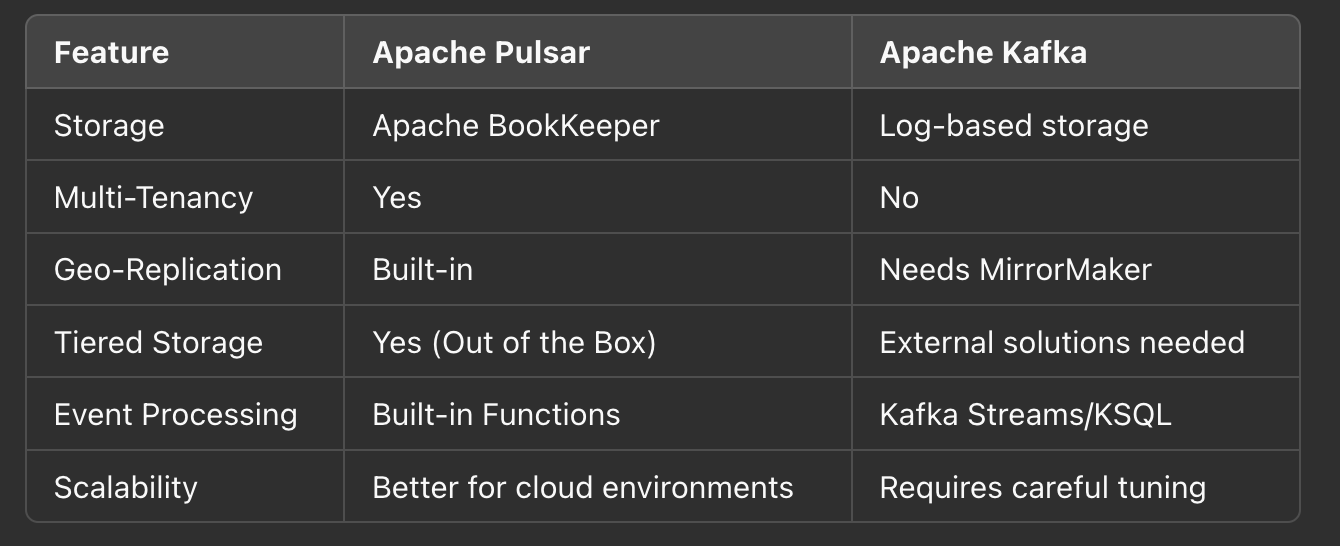
Apache Pulsar is the event-driven messaging system that swoops in like a caped hero when your data needs a reliable, scalable, and high-throughput home. Think Kafka, but with a sprinkle of real-time charm and a lot of built-in durability. If you’re wondering whether Pulsar is still relevant in 2025, the short answer is: absolutely. The longer answer? Buckle up.
What Is Apache Pulsar?
Pulsar is an open-source, cloud-native distributed messaging and event-streaming platform developed at Yahoo! before being donated to the Apache Software Foundation. It’s designed to handle high-throughput, low-latency messaging while ensuring data durability and scalability across multiple geographic regions.
At its core, Pulsar supports:
- Pub-Sub Messaging: Producers publish messages, and consumers subscribe to topics.
- Stream Processing: Ideal for real-time analytics.
- Multi-Tenancy: Supports multiple applications in a single cluster.
- Geo-Replication: Data can be replicated across multiple data centers effortlessly.
Why Should You Care?
If you’ve ever wrangled Kafka and thought, “There has to be an easier way,” Pulsar might be your new best friend. Unlike Kafka, which relies on Zookeeper for metadata, Pulsar separates its storage and messaging layers with Apache BookKeeper, making it more flexible and resilient.
Pros and Cons
Pros:
✅ Multi-Tier Architecture — Pulsar’s decoupled storage and compute layers make scaling painless. ✅ Built-in Geo-Replication — No extra hacks needed to keep your data consistent across the globe. ✅ Multi-Tenancy — You can run multiple independent applications on the same cluster without stepping on each other’s toes. ✅ Durability & Ordering Guarantees — Your messages won’t disappear into the void. ✅ Seamless Elastic Scalability — Scale up and down without data loss or performance dips.
Cons:
❌ Higher Complexity — It has more moving parts than Kafka, which might make initial setup daunting. ❌ Smaller Ecosystem — While growing, it still doesn’t match Kafka’s vast adoption. ❌ Learning Curve — If you’re migrating from Kafka, expect a little unlearning.
Who Uses Pulsar?
Pulsar is increasingly being adopted by companies that need high-performance real-time messaging, including:
- Tencent (handling real-time messages at massive scale)
- Yahoo! Japan (powering its notification system)
- Splunk (for real-time data ingestion)
- Iterable (event-driven marketing automation)
How Does It Compare to Kafka?
Pulsar and Kafka both operate in the same event-streaming space, but Pulsar has a few tricks up its sleeve:

While Kafka has the bigger community, Pulsar is quickly catching up, especially in cloud-native architectures.
Use Cases
Pulsar shines in scenarios like:
- Financial Trading — Millisecond-level latency messaging for stock trades.
- IoT Data Streams — Handling sensor data from thousands of devices.
- Event-Driven Microservices — Decoupling services for improved scalability.
- AI & Machine Learning Pipelines — Streaming real-time data to AI models.

Does Pulsar Work Well With AI?
Yes! Pulsar’s real-time capabilities make it an excellent fit for AI-driven applications. Whether it’s feeding live data into machine learning models or triggering AI-driven alerts, Pulsar’s low-latency streaming can help keep your AI smarter and faster.
Is Pulsar’s Popularity Growing?
Yes, but slowly. While Kafka still dominates in legacy enterprise environments, Pulsar is becoming the go-to choice for cloud-native applications. Google Trends shows a steady increase in Pulsar-related searches, and adoption rates are rising in fintech, gaming, and IoT sectors.
The Future of Pulsar
With growing enterprise adoption and improvements in ease of deployment (thanks to Kubernetes integrations), Pulsar’s trajectory is promising. If you’re looking for a next-generation messaging solution that won’t buckle under scale, Pulsar deserves a serious look.
Art Prompt:
A vibrant Impressionist painting, evoking the style of Monet, depicting a futuristic cityscape illuminated by the neon glow of countless streaming data pipelines. The brushstrokes capture the dynamic movement of information flowing like a river through towering skyscrapers, with abstract figures representing data scientists and engineers orchestrating the digital symphony. The reflections on wet cobblestone streets mirror the dazzling lights, creating a dreamlike effect of technology meeting timeless artistry.

Want more tech insights and AI-powered humor? Follow me and drop a comment below — let’s talk data streams and bad puns!